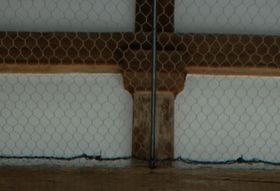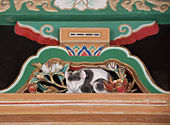- Nakazonae
-
Nakazonae (中備・中具) are decorative intercolumnar struts installed in the intervals between bracket complexes (tokyō) at Buddhist temples and Shinto shrines in Japan.[1]
In origin they were necessary to help support the roof, however at the end of the 10th century the invention of the hidden roof[note 1] made them superfluous.[2] They remained in use, albeit in a purely decorative role, and are typical of the Wayō style. The Zenshūyō style used by Zen temples has instead bracket complexes even between posts.
Contents
Kentozuka
The simplest of these struts are the kentozuka (間斗束 lit. interval block strut, see photo above) composed of a short post and a bearing block.[3]
Minozuka
Similar to the kentozuka is the fan-shaped strut called minozuka (蓑束, lit. straw raincoat strut) (see gallery), which can have decorations on the two sides called 笈形 (oigata) or a collar-like decoration between post and bearing block. The name comes from its shape, similar to that of a traditional straw raincoat called mino.[4]
Hana-hijiki
A variant of the kentozuka is the hana-hijiki (花肘木), composed by either one or two horizontal series bearing blocks standing over an elaborately carved floral pattern.[1]
Warizuka
The warizuka (割束) strut consists of a wooden inverted V topped by a bearing block.[3]
Kaerumata
The kaerumata (蛙股・蟇股 lit. frog legs) was named after its shape, resembling a frog's splayed legs.[1]
Its origins are not known with certainty, but it may be an evolution of the warizuka.[1] Invented during the 12th century, it became gradually more and more elaborate, to the point where in the Edo period the strut itself would be hidden behind the decorations.[1]
Two basic types exist. In the case of the sukashi-kaerumata (透蟇股), the space above and between the frog legs is either empty or carved. In the case of the ita-kaerumata (板蟇股), the space between the legs has completely disappeared, leaving behind a solid board with an external frog-leg profile.[5]
Types of nakazonae
-
Minozuka (Rōmon, Hongaku-ji, Kamakura)
-
Warizuka (sides) and tokyō (center) (Hōryū-ji)
-
Sukashi-kaerumata (Kitano Tenman-gū)
-
Hana-hijiki, center, between two tokyō (Hōryū-ji, Nandaimon)
Notes
- ^ The hidden roof (noyane (野屋根)) is a structure, composed of a true roof with a second roof beneath, which permits to obtain a heavily slanted roof with arbitrarily shallow eaves. Having its own, hidden roof support system, it made the nakazonae largely redundant.
References
- ^ a b c d e Nishi, Kazuo; Hozumi, Kazuo (1996) [1983]. What is Japanese architecture? (illustrated ed.). Kodansha International. pp. 39–40. ISBN 4770019920.
- ^ Parent, Mary Neighbour. Japanese Architecture and Art Net Users System. Nakazonae, retrieved on April 28, 2011
- ^ a b Parent, Mary Neighbour. Japanese Architecture and Art Net Users System. Kentozuka, retrieved on April 19, 2011
- ^ Parent, Mary Neighbour. Japanese Architecture and Art Net Users System. Minozuka, retrieved on April 28, 2011
- ^ Parent, Mary Neighbour. Japanese Architecture and Art Net Users System. Kaerumata, retrieved on April 19, 2011
Elements of Japanese architecture Styles Buddhist · Buke · Daibutsuyō · Gassho · Giyōfū · Hachiman · Hirairi · Hiyoshi (also called Hie) · Irimoya · Ishi-no-ma · Kasuga · Kibitsu · Nagare · Ōbaku Zen · Setchūyō · Shinden · Shinmei · Shinto · Shoin · Sukiya · Sumiyoshi · Taisha · Wayō · ZenshūyōBuilding types Roof styles Structural Burdock piling · Chigi · Disordered piling · Engawa · Fusuma · Hisashi · Irimoya-zukuri · Irori · Jinmaku · Katōmado · Katsuogi · Kuruwa · Mokoshi · Moya · Nakazonae · Namako wall · Nightingale floor · Onigawara · Ranma · Shōji (see also washi) · Sōrin · Tamagaki · Tatami · Tokonoma · Tokyō · Tsumairi · ShibiGates and approaches Rooms Furnishings Outdoor objects Measurements Groups See also Shinto shrine Shinto architecture Buildings - chōzuya or temizuya
- haiden
- heiden
- hokora
- honden / shinden / shōden
- kagura-den
- massha
- sessha
Architectonic elements Styles - hirairi-zukuri
- tsumairi-zukuri
- gongen-zukuri
- hachiman-zukuri
- hiyoshi-zukuri
- irimoya-zukuri
- ishi-no-ma-zukuri
- kasuga-zukuri
- kibitsu-zukuri
- misedana-zukuri
- nagare-zukuri
- ōtori-zukuri
- owari-zukuri
- ryōnagare-zukuri
- shinmei-zukuri
- sumiyoshi-zukuri
- taisha-zukuri
Others Implements Main kami Staff Head shrines1 - Fushimi Inari Taisha
- Usa Hachiman-gū
- Ise Grand Shrine
- Dazaifu Tenman-gū
- Munakata Taisha
- Suwa Taisha
- Hiyoshi Taisha
- Kumano Nachi Taisha
- Tsushima Shrine
- Yasaka Shrine
Miscellaneous 1 (in order of the size of the shrine network they head)
Buddhist temples in Japan Japanese Buddhist architecture Architectonic elements Mon (gates) Buildings Chinjusha · chōzuya/temizuya · -dō · main hall (kon-dō, hon-dō, butsuden) · kuri · kyōzō or kyō-dō · shoinTō or Buttō (pagodas) Styles Others A-un · kenSchools and objects of worship Major schools Zen schools Nanto rokushū Objects of worship Amida Nyōrai · Benzaiten · Dainichi Nyorai · Jizō · Kannon · Marishi-ten · Shaka Nyorai · Shitennō (Four Kings) · Twelve Heavenly Generals (Jūni Shinshō) · Yakushi NyoraiOther elements Implements Others bussokuseki · butsudan · Glossary of Japanese Buddhism · Japanese Buddhist pantheon · jingū-ji · miyadera · saisenbakoCategories:- Japanese architecture
- Japanese architectural features
-
Wikimedia Foundation. 2010.







